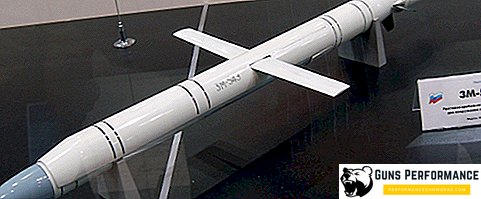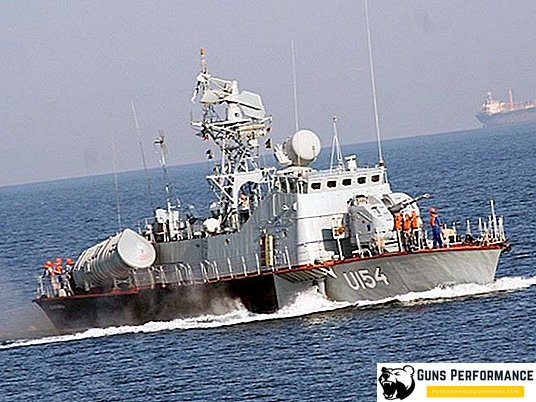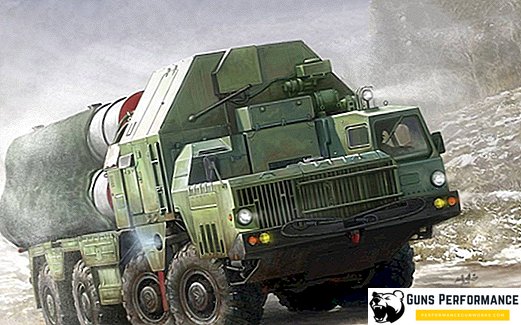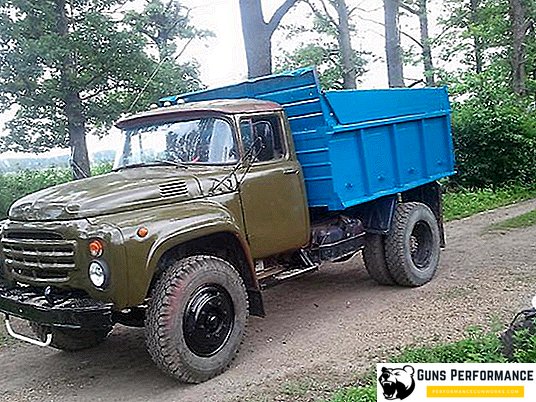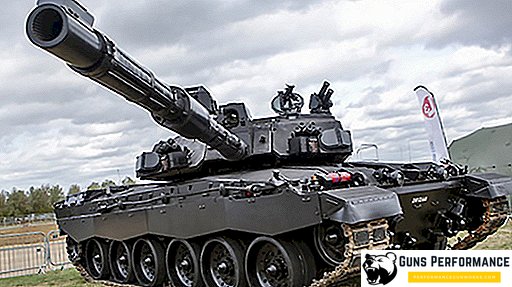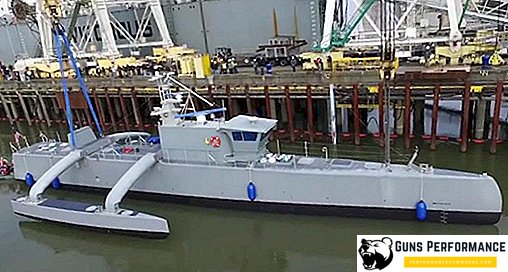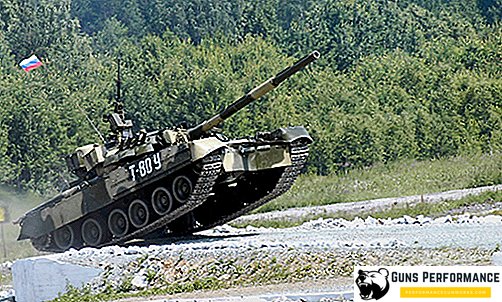
Self-propelled artillery installation (SAU) is a type of combat vehicle, which is an artillery gun mounted on a wheeled or tracked self-propelled platform. Self-propelled units are used to support tanks or infantry in defense or attack.
The "finest hour" of self-propelled artillery installations was the Second World War. After its completion, they were driven out by more efficient and versatile (albeit more expensive) tanks. The second birth of the ACS falls on 60-70 years of the last century. However, both in their design and in the concept of using the machine of this time were already completely different from the self-propelled guns of the war.
During the war, self-propelled guns solved almost the same tasks as the tanks: they destroyed the enemy’s armored vehicles, went with the infantry units to attack, fired on enemy defenses. The most actively used the ACS of the Nazis. In the German self-propelled classification, there were special tank destroyers and several types of assault guns. They even used self-propelled anti-aircraft installations created on the basis of tanks. However, the further development of the concept of the main battle tank (MBT) led to the disappearance of tank destroyers and assault guns.
In the mid-1960s, the development of the “flower” series of self-propelled artillery units began in the USSR. Deadly cars were named after beautiful garden plants. One of these "flowers of war" was the 122-mm ACS 2S1 "Carnation".
This combat vehicle was in service with the Soviet army for many years, it was actively exported, today the Gvozdika self-propelled gun is used by the armed forces of Russia, and also in several dozen armies of the world. In addition to the USSR, self-propelled installation 2S1 "Gvozdika" was produced under license in Poland and Bulgaria.
In the early 80s the Soviet Big 7 poster was issued by the US military. It showed the most dangerous weapons of the Soviet ground forces. Among the depicted samples was the self-propelled gun "Carnation".

During operation, this artillery installation experienced several upgrades, on its basis many specialized combat vehicles were developed, some of which also went into series.
SAU 2S1 "Gvozdika" took part in a large number of conflicts, during which it showed its high reliability and efficiency.
History of creation
After the war ended, it became clear that the old concept of using self-propelled artillery as assault guns and tank destroyers was outdated. At the same time, another trend emerged: self-propelled artillery began to crowd out the towed. Self-propelled guns were more rapid and maneuverable, had a significant range of fire, good protection, could more successfully support their own troops on the defensive and conduct an artillery offensive.
Already in the fifties, many countries began active work on new models of this military equipment. For a long time in the USSR, more resources were allocated for the development of rocket weapons, often at the expense of aviation and barreled artillery. However, later, Soviet strategists nevertheless concluded that a large-scale war was unlikely, since it would lead to mutual nuclear annihilation and began to prepare for local conflicts. Actively engaged in the creation of new models of self-propelled artillery guns began after the resignation of General Secretary Khrushchev.

In 1965, exercises were carried out, which clearly showed a significant backlog of Soviet self-propelled artillery from its Western counterparts. In 1967, the USSR Council of Ministers decree on the beginning of work on the creation of a 122-mm self-propelled artillery installation, which later received the name 2S1 "Gvozdika", was released.
Initially, there were three variants of the chassis for the self-propelled gun: it was proposed to create it on the basis of the BMP-1, the MTLB tracked carrier, and also on the basis of the SU-100P chassis. The main armament of the new ACS was to become the 122-mm howitzer D-30.
The variant with the SU-100P was eliminated almost immediately, after modernization, it was decided to use the MTLB tractor as a base for the new self-propelled guns. Initially, this tractor had insufficient stability and did not suit the designers for the permissible loads on the undercarriage. Therefore, the base MTLB had to extend and introduce one additional support roller on each side.
2S1 "Carnation" was supposed to replace the 122-mm howitzer D-30 and M-30 in the artillery units of the motorized rifle regiments. In 1969, four samples were ready for field tests.
The Kharkov Tractor Plant (HTZ) was appointed the lead developer of the installation. Self-propelled howitzer was designed in the OKB-9.
The tests carried out showed a high level of gas pollution in the self-propelled gun crew during the shooting. Later managed to cope with this problem. Work was also carried out on the creation of a cannon-cap tool, but they ended without result. This type of loading did not give any significant advantages, either in range or in accuracy of shooting.
In 1970, ACS 2S1 "Gvozdika" adopted. The following year, the mass production of an artillery installation began, only in 1991 it was completed. In 1972, a parachute system was developed for landing the “Carnation” from the air, but it was never adopted by the Airborne Forces Airborne.
In 1971, the car began to produce under license in Poland. In 1979, licensed production was launched in Bulgaria. Bulgarian self-propelled guns in their technical characteristics inferior to Soviet models.

Description of construction
The body of a self-propelled artillery installation has a classic scheme for these machines: in the front of the machine there is a power compartment and a control compartment, and a fighting compartment is located in the middle and rear. The body is welded from rolled armor plates, it provides protection from bullets and fragments, is completely sealed and allows ACS to overcome water obstacles by swimming. Armor "Carnations" "holds" a bullet of 7.62 mm caliber with a range of three hundred meters. The 122-mm cannon is mounted in a rotating turret, with space for the crew.
The low weight of the ACS allows it to be transported using transport aircraft.
The power compartment of the artillery unit is located in the nose of the machine to the right, on the left side of it is the driver's seat, instruments and controls. On the left side of the tower is the place of the loader and sights, behind him is the place of the commander of the machine. The place of the installation commander is equipped with a swiveling turret. Charger is located on the right side of the tower.
In the tower SAU 2S1 "Carnation" is 122-mm cannon 2A31. According to its characteristics and used ammunition, it is completely identical to the 122-mm howitzer D-30. The gun consists of a pipe, dual-chamber muzzle brake, ejector and breech. An electromechanical rammer is used to disarm ammunition. The corners of the vertical guidance of the gun - from -3 to + 70 °. Shooting can be carried out by projectiles from the ground; a large stern door is used to feed them. In this case, the rate of fire SAU 2S1 "Carnation" is from four to five shots in one minute, when shooting "from the side" it is reduced to two shots per minute.

The firing range of the self-propelled unit is from 4070 to 15200 meters.
Ammunition SAU 2S1 "Carnation" is forty shots, some of the shells are along the side walls of the hull, and part is located along the rear and side walls of the tower. Self-propelled installation can use a wide range of ammunition: high-explosive, cumulative, chemical, propaganda, smoke, lighting. Shells can be equipped with various types of fuses. Especially for the artillery installation 2S1 "Gvozdika" were developed adjustable ammunition "Kitolov."
In 1997, specifically for this machine was developed active-jet 122-mm projectile, which allows you to increase the firing range to 21.9 km.
The fire control system of the ACS consists of a combined aiming device TKN-3B, which can be used at any time of the day, as well as two TNC-170A periscopic sights. All of them are installed in the commander's turret. The gunner has a panoramic sight 1OP40 (used for firing from closed positions) and an OP5-37 sight, which is used during direct fire. The places of the driver and loader are equipped with surveillance devices.
The car is equipped with a V-shaped diesel engine YMZ-238N with eight cylinders. Its maximum power is 300 liters. with. The transmission is manual, has six gears forward and one - back. Fuel tanks are in the walls of the sides of the car, their total volume is 550 liters, this is enough to overcome 500 km on the highway.
Chassis self-propelled installation is a modified chassis MTLB tractor. Two additional road wheels were introduced into it. The guide wheels are in the rear of the unit, and the drive wheels are in the front. The self-propelled caterpillar width is 400 mm; if necessary, the caterpillars with a width of 600 mm can be installed on the machine, which significantly increases the ACS throughput.
The self-propelled gun "Carnation" is able to overcome water obstacles. Movement in water occurs due to the rewinding of the tracks, the maximum speed of the machine is 4.5 km / h.
Modifications of the self-propelled unit
Since the launch of the ACS in serial production, several modifications of the machine have been created:
- 2S1M1 - Russian version with a new fire control system 1V168-1.
- 2S34 "Khosta" - Russian version, developed in 2003. It has a howitzer 2A80-1 and a 7.62-mm PKT machine gun on the commander's turret. In 2008, adopted by the Armed Forces.
- 2C1T Goździk. Polish modification of self-propelled guns with an improved TOPAZ fire control system.
- Rak-120. Another Polish modification, which was created in 2008-2009. The 122-mm gun was replaced with a 120-mm mortar with an automatic loader. Ammunition - 60 shots.
- Model 89 - Romanian modification, created in the 80s. The machine used the BMP MLI-84 chassis.
- Raad-1 - Iranian 122-mm self-propelled howitzer, mounted on the chassis of the BMP Boragh.
Modernization 2S1 "Carnations" started in Ukraine. In 2018, KhTZ received three self-propelled guns. They planned to install the Swedish Volvo engine, a new electrical equipment, modern communication systems and navigation of Ukrainian production.
In addition to modifications, in different years several special vehicles were created on the basis of the Gvozdika SAU: the 2S8 Astra self-propelled mortar, the Norov self-propelled anti-tank gun 2S15, the Nona-SV self-propelled gun, the RSZ tracked version of the Grad and the multi-purpose tractor 2S1-H.
The creation of various machines on the basis of ACS "Gvozdika" engaged in other countries:
- The BMP-23 is an infantry fighting vehicle created in Bulgaria. It was installed 23-mm cannon 2A14 and ATGM "Baby".
- LPG - artillery fire control machine. It can also be used as an ambulance.
- The HTZ-26N is a Ukrainian snow and swamp-going vehicle based on the chassis of the ACS "Gvozdika".
- TGM-126-1 - Ukrainian transport vehicle on 2S1 chassis.

Organizational structure
This self-propelled howitzer entered the artillery divisions of tank and motorized rifle regiments. The division consisted of three batteries, each of which had six self-propelled guns. Total, the division consisted of sixteen SAU.
Combat use of ACS "Gvozdika"
The first serious conflict in which Gvozdika took part was the war in Afghanistan. Usually, the 2S1 batteries followed the assault units and were firing direct fire. Less commonly, installations were used for firing from closed positions. On the whole, “Carnations” have shown themselves quite well in difficult Afghan conditions.
Self-propelled installation "Gvozdika" participated in almost all conflicts that took place on the territory of the former USSR after its collapse.
"Carnations" were used by the troops of the unrecognized Transnistrian Republic against the Moldovan armed forces. Used these installations and in the course of the Civil War in Tajikistan.
Russian federal troops used 2S1 in the first and second Chechen campaigns. During the first war, several self-propelled guns with ammunition were captured by Chechen separatists.
"Carnations" were used during the Georgian-Ossetian conflicts. These machines are actively used in the east of Ukraine by both government troops and separatists.
SAU "Carnations" was used during the Yugoslav wars by all participants in the confrontation.
Back in the 1980s, the Gvozdiki SAU were delivered to Iraq and took part in the Iran-Iraq conflict. Then the Iraqi army used them against coalition forces in 1991. It should be noted that the Soviet artillery (both reactive and barreled) showed itself in that war not from the best side.
In 2010-2011 during the Civil War in Libya, the Gvozdiki was used by government forces against the rebels. Currently, these machines are actively used by almost all the warring parties in the Syrian conflict. They were supplied in large quantities to Syrian government forces and often fell into rebel hands as trophies. They are used as the Front of en-Nusra, and banned in Russia by ISIS.
There is information that the Gvozdika ACS was used by Hussite rebels during the fighting in Yemen.

Specifications
Below are the TTX 2S1 "Carnation".
| Crew, pers. | Four |
| Mass, t | 15,7 |
| Length m | 7,26 |
| Height, m | 2,74 |
| Width, m | 2,85 |
| Maximum speed: | |
| on the highway, km / h | 60 |
| afloat km / h | 4,5 |
| Cruising on the highway, km | 500 |
| Armament | 122 mm howitzer D-32 (2A31) |
| Ammunition, shells | 40 |
| Gun type | rifled howitzer |
| Firing range, km | to 15.2 |
| Engine | YaMZ-238N |
| Engine power, l. with. | 300 |
| Booking | Bullet and splinterproof |



